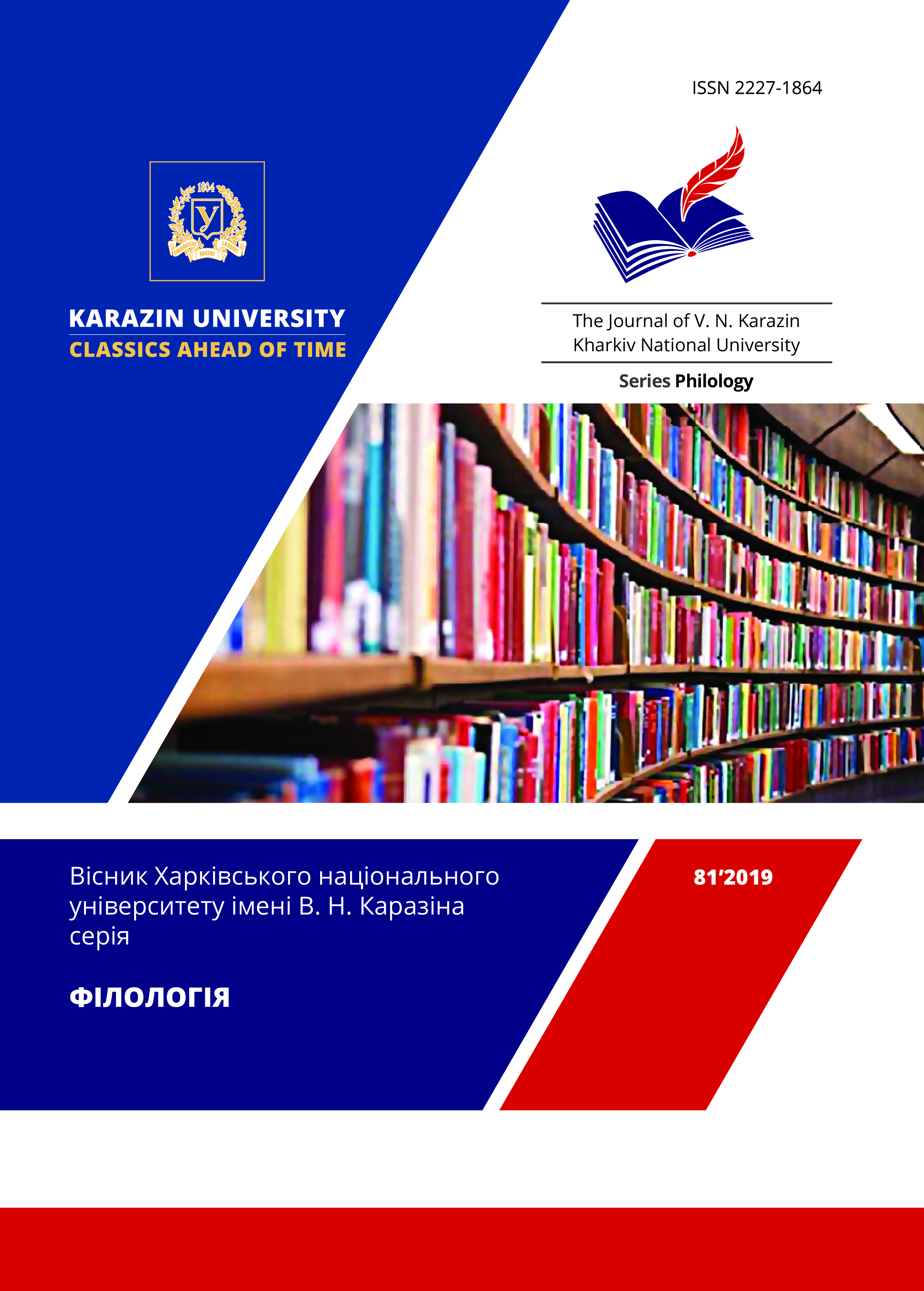Reception of Doris Lessing`s literary works literary works in scientific discourse
Abstract
The article is devoted to the study of literary heritage reception of modern British writer Doris Lessing, whose work had a significant influence as on the development of English and American literature at XX – XXI centuries, and the feminist thought as well. The article outlines the state of study of the question concerning research of the writer's creativity in contemporary foreign and national literary criticism. Different approaches of the literary critics concerning the analysis of Doris Lessing`s novels are systematized. The main research vectors of the writer's creative heritage are determined. In foreign literary critique writer`s novels were studied mainly in feminist discourse. The attention of scholars was concentrated mainly on the works of “Golden Notebook”, “Grass is singing”, “Children of Violence”.
In the national scientific discourse were revealed such following directions of studying of the D. Lessing`s heritage, as: 1) psychological approach (M. Horlach, I. Zimomriia, V. Lutsyk, M. Mykolaichyk); 2) identification of writer's artistic thinking features in the aspect of feminism (V. Savina, L. Miroshnychenko, I. Shapovalova); 3) an analysis of socio-political aspects of author`s creativity (L. Miroshnichenko, A. Shpytal); 4) poetical investigation of D. Lessing`s poetics works (M. Gorlach, V. Kramar) 5) discovery of the cultural-historical context V. Lutsyk, L. Miroshnichenko); 6) revealing features of the writer's creative method (O. Podkoritovа); 7) paratextual approach (L. Miroshnichenko).
In foreign literature, the following main aspects of the study of the legacy D. Lessing were revealed: 1) feminist (L. Scott); 2) historical (S. Watkins, M. Drebl, G. Green); 3) psychological (B. Drain, P. Perrakis); 4) culturological K. Fishburne, N. Hardin); 5) a comparative approach (L. Scott); 6) eco-feminist approach (N. Aldeeb); 7) pedagogical (T. Sperlinger).
Downloads
References
Horlach M. V. Zhinka yak Insha v romani Doris Lessinh “Zolotyi zapysnyk” [Woman as Another in Doris Lessing`s novel “Golden Notebook”]. Available at : https://docviewer.yandex.ua/?url=yaserp%3A%2F%2Flnu.edu.ua%2Ffaculty%2Finomov.new%2Fukrainian%2Fhorlach.doc&lang=uk&c=555caa39f00c
Horlach, M. V. (2014) Problemy vidminnosti u multykulturnomu prostori khudozhnikh tvoriv D. Lessinh [Problems of difference in the multicultural space of D. Lessing`s artistic works]. Zb. Literaturoznavchi obrii. Pratsi molodykh uchenykh. Zb. nauk. prats. No. 20, pp. 18—17.
Kramar, V. B. (2018) Postmodernistska poetyka tvoriv Dzhona Apdaika i Doris Lessinh [Postmodern poetics of John Updike and Doris Lessing]. Vyd. ChDU im. Petra Mohyly. Vyd. Filolohiia. Literaturoznavsto [Philological Science], no.152, pp. 50—53
Lutsyk, V. I. (2014) Obraz Londona u malii prozi Doris Lessinh: nova paradyhma mizhosobystisnykh stosunkiv [The Image of London in Small Prose of Doris Lessing] Visn. Khark. nats. un-tu im. V. N. Karazina. Ser.: Filolohiia [Philological Science], no. 1027 (71), pp. 191—196.
Mykolaichyk, M. V. (2014) Osoblyvosti psykholohizmu v romanakh Doris Lessinh [Features of psychology in Doris Lessing`s novels]. [PhD Thesis]. Simferopol. [in Ukranian]
Miroshnychenko, L. Ya. (2012) Istoriia ta nostalhiia v romanakh Doris Lessinh [History and nostalgia in the novels of Doris Lessing]. Visnyk Zaporizkoho natsionalnoho universytetu. Filolohichni nauky, [Philological Science], no. 3, pp.173—180.
Miroshnychenko, L. Ya. (2012) Paratekst i yoho funktsii u romani Doris Lessinh “Ushchelyna” [Paratect and its functions in Doris Lessing's novel “Cleft”]. Inozemna filolohiia [Philological Science], no.124, pp. 269—277
Rudnev, V. P. (2005) Slovar bezumiya [Dictionary of insanity]. Moscow : Nezavisimaya firma «Klass». [in Russian]
Savina, V. V. (2014) Spetsifika izobrazheniya mira zhenschinyi v feministskih romanah Doris Lessing [Specificity of the image of the women world in Doris Lessing feminist novels]. Visn. Hark. nats. un-tu im. V. N. Karazina. Ser.: Filologiya [Philological Science], no. 1027 (71), pp.196-200.
Shpytal, A. (2009) Doris Lessinh [Doris Lessing] Slovo i chas [Word and time]. No. 10, pp. 22—25.
Aldeeb, N. R. (2017) Ecofeminism in Doris Lessing’s Mara and Dann: An Adventure. AWEJ for translation & Literacy Studies, pp. 78—85.
Perrakis, P. (1992) Touring Lessing’s Fictional World. Science Fiction Studies. Vol. 19. No. 56, pp. 95—99.
Scott, L. (1997) Similarities Between Virginia Woolf and Doris Lessing [Electronic journal]. Deep South. Vol. 3. No. 2. Available at :http://www.otago.ac.nz/deepsouth/vol3no2/scott.html.
Sperlinger, T. (2017) Radical Pedagogy in Doris Lessing’s Mara and Dann. Critique: Studies in Contemporary Fiction. Vol. 58, pp. 300—311.
Whilson, S. R. (2013) Storytelling in Lessing’s Mara and Dann and Other Texts. Women's Utopian and Dystopian Fiction. Cambridge: Cambridge Scholars Publishing, pp. 23—30.
[Electronic resource]. Available at : https://www.nobelprize.org/nobel_prizes/literature/laureates/2007/




